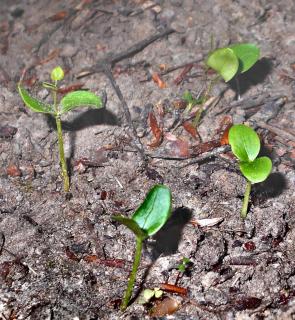

You can increase the germination of katsura tree seeds with a few simple tricks. This makes for an experiment much worth trying at home!
The normal germination rate of dry, dormant katsura seeds usually is around 25 to 40%. This is for both Cercidiphyllum japonicum and Cercidiphyllum magnificum.
Read also:
In laboratories, rates for dormant seeds hover around 40%. However, this is usually in conditions of perfect temperature and moisture. Actual rates in home settings are lower.
You can double germination rates with stratification. This means to set the seeds in a damp, cold place for about a week.
For katsura seeds, an effective stratification is the following:
Stratification nearly doubles germination rates. After stratification, from 60 to 90% of the seeds should germinate, as opposed to 40% without.
Exposing seeds to grow lights for most of the day also helps, but only for seeds that haven’t been stratified.
Light treatment only increases germination rates from 40 to anywhere between 40 (no improvement) and 60%. It isn’t as effective as stratification.
Spread the seeds on a tray on a piece of moist cloth or absorbent paper. Filter paper works well for this (as in coffee filters).

If a male Cercidiphyllum magnificum is growing not far from your female C. japonicum, or vice-versa, there’s a chance not many seeds will be viable and sprout.
Katsura is a dioecious plant. Each tree is either male OR female, but never both.
Male trees don’t bear fruit or seeds pods.
Female trees require male trees to bear fruit – they are not self-pollinating.
Any male of that species will do, as long as it’s really the same species (both C. japonicum or both C. magnificum). Within the species, any of the other katsura varieties will be compatible.
If your tree isn’t bearing seeds, it may be for the following causes:
Lastly, your katsura tree may be too young. A tree must usually be several years old before the first flowers appear and it can propagate.
Read also:
Sources
Stratification and Light Improve Germination of Katsura Tree Seed, Michael S. Dosmann, Jeffery K. Iles, Mark P. Widrlechner, 1999, Iowa State University & US Department of Agriculture
Credits for images shared to Nature & Garden (all edits by Gaspard Lorthiois):
Four katsura seeds by Józef Babij under © CC BY-SA 2.0
Katsura seedlings by Salicyna under © CC BY-SA 4.0
I have a 30-40y.o. Katsura tree next to the driveway and it has been annoyingly prolific in the seed production this winter/spring. I have blown off my car and driveway thousands of the little dark banana-shaped 3/4″ seed pods for 2 months now. I don’t remember having such seed production for so long before this year. I am a forester and have pruned it religiously and it’s healthy. What is the seed cycle of this tree? For example, some conifers have a 7-yr cycle in which they produce a prolific crop of cones.
That’s a good question, Marc. It’s true that many trees have fruiting cycles. It helps to regulate predators that would eat all seeds. Years of meager fruiting starve animals like boars and deer, so their populations don’t reproduce much. And then a year of abundance means that lots of seeds survive to sprout. And then the cycle starts again.
To be honest, I know this to be true for trees like oak and beech, but I haven’t yet heard of it with Cercidiphyllum. Such behaviors tend to develop when entire swaths of forest are covered with the same species, as you mentioned with conifers. Lone trees usually don’t have an evolutionary advantage in that. It would make sense to check what happens in places where Katsura is native from.
A last explanation is the “last year” syndrome, where a weakened or dying tree will bloom and seed like crazy only to die shortly thereafter. I would doubt this is happening with yours, it isn’t yet very old!